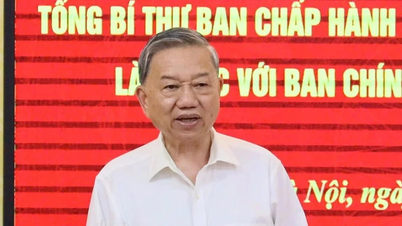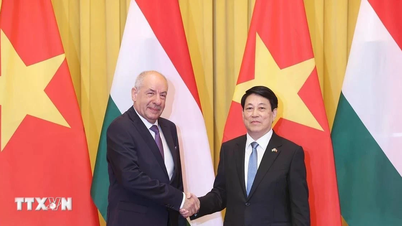In the story of improving the quality of human resources to meet the goals set out in Resolution 57, at the seminar Training high-quality human resources : Impetus from Resolution 57 organized by the People's Representative newspaper , Dr. Le Truong Tung - Chairman of the Board of Directors of FPT University said that the student finance model is an issue that has not received due attention.
“Everyone understands that ‘you need food to practice religion’. Without enough money for universityeducation or with low money, it is very difficult to achieve the desired quality,” Dr. Tung affirmed.
Mr. Tung said that currently, the average tuition fee of Vietnamese higher education is in the lowest segment in the world . If we consider higher education as a service, we have a service with a very low price and cannot be exported. Meanwhile, higher education for many countries is one of the top 5 export sectors.

Therefore, in planning, we must talk about resources for developing higher education, and one of the important indicators is the average cost to train a student.
This cost comes from many sources, not tuition fees. We have to compare the current cost of educating a student in Vietnam with other countries in the region.
"What will be the target number in 5-10 years, what solutions are there to achieve that number, what percentage will be contributed by learners, how will the State participate, and especially importantly, what will be the credit mechanism...", the Chairman of the Board of Directors of FPT University raised the question.
According to Mr. Tung, student loans mean using future resources to invest in the present. Students will pay with their own earnings in the future, meaning they borrow from the future to spend on the present.
"I believe that in the future, most of you will be fine and can handle this. However, currently, student loans are very small, the scale is small, and the amount is small compared to other countries," he analyzed.
The investment cost to train a student must be settled by credit, and credit must go through the State. Universities only have certain policies on granting scholarships or policies on studying first and paying later.
“FPT University is doing this because the State has not responded to this issue. We hope the State will resolve this issue in a systematic manner,” said Mr. Tung.
In addition, he also hopes that Vietnamese parents will change their concept of investing in higher education. Because a large number of parents do not care about the cost of education. That is because from the past until now, we still have the mentality that going to school is free or that tuition is only symbolic.

As for developing countries, even from the time they start having children, parents have to have a savings plan for an education fund so that their children can study in better schools later, even though those countries have very good credit mechanisms.
“So what is expensive, what is cheap? The average tuition fee in many countries is often compared to the average salary - the rule is that working for 1 year can pay for 2 years of tuition. That is, if you study for 4 years, it will take 2 years of working to pay off the tuition loan. The current tuition fee structure in Australia and the US is the same. Of course, for some schools with higher investment or higher quality, the tuition fee may be higher,” Mr. Tung compared.
Sharing more about this issue, Mr. Chu Duc Trinh, Principal of the University of Technology (Vietnam National University, Hanoi) said that in the world, there are 2 ways to calculate the average tuition fee of students. Method 1 is as Dr. Le Truong Tung said, method 2 calculates the average tuition fee at 50% of the average GDP per capita at the time of study.
Vietnam's current GDP per capita is nearly 5,000 USD. If calculated by that rule, 1 year of tuition is nearly 2,500 USD.
“If we put that cost on the shoulders of the students, it will be very difficult, so we really hope that in the coming time, the Government will invest more in schools, especially in building facilities and practice equipment. Private schools have many advantages, but our public schools have difficulties, so the State must have policies and not let students bear all the burden. Autonomy does not mean autonomy in everything, but autonomy under certain conditions,” said Mr. Trinh.
In response to the "concerns" of representatives of higher education institutions, Deputy Director of the Department of Higher Education Nguyen Anh Dung said that the Ministry of Education and Training is building a strategic framework for higher education development, in which many contents related to financial issues are presented in the draft.
The Ministry also hopes to receive comments and recommendations from universities and businesses to advise competent authorities, in order to ensure the quality of university education meets the expectations of businesses as well as the development needs of the country.
Source: https://archive.vietnam.vn/hoc-phi-dai-hoc-trung-binh-2-500-usd-nam-dung-de-sinh-vien-phai-ganh-tat-ca/


![[Photo] Vietnamese and Hungarian leaders attend the opening of the exhibition by photographer Bozoky Dezso](https://vphoto.vietnam.vn/thumb/1200x675/vietnam/resource/IMAGE/2025/5/28/b478be84f13042aebc74e077c4756e4b)
![[Photo] General Secretary To Lam works with the Central Policy and Strategy Committee](https://vphoto.vietnam.vn/thumb/1200x675/vietnam/resource/IMAGE/2025/5/28/7b31a656d8a148d4b7e7ca66463a6894)

![[Photo] 12th grade students say goodbye at the closing ceremony, preparing to embark on a new journey](https://vphoto.vietnam.vn/thumb/1200x675/vietnam/resource/IMAGE/2025/5/28/42ac3d300d214e7b8db4a03feeed3f6a)

![[Photo] Prime Minister Pham Minh Chinh receives a bipartisan delegation of US House of Representatives](https://vphoto.vietnam.vn/thumb/1200x675/vietnam/resource/IMAGE/2025/5/28/468e61546b664d3f98dc75f6a3c2c880)


















































































Comment (0)